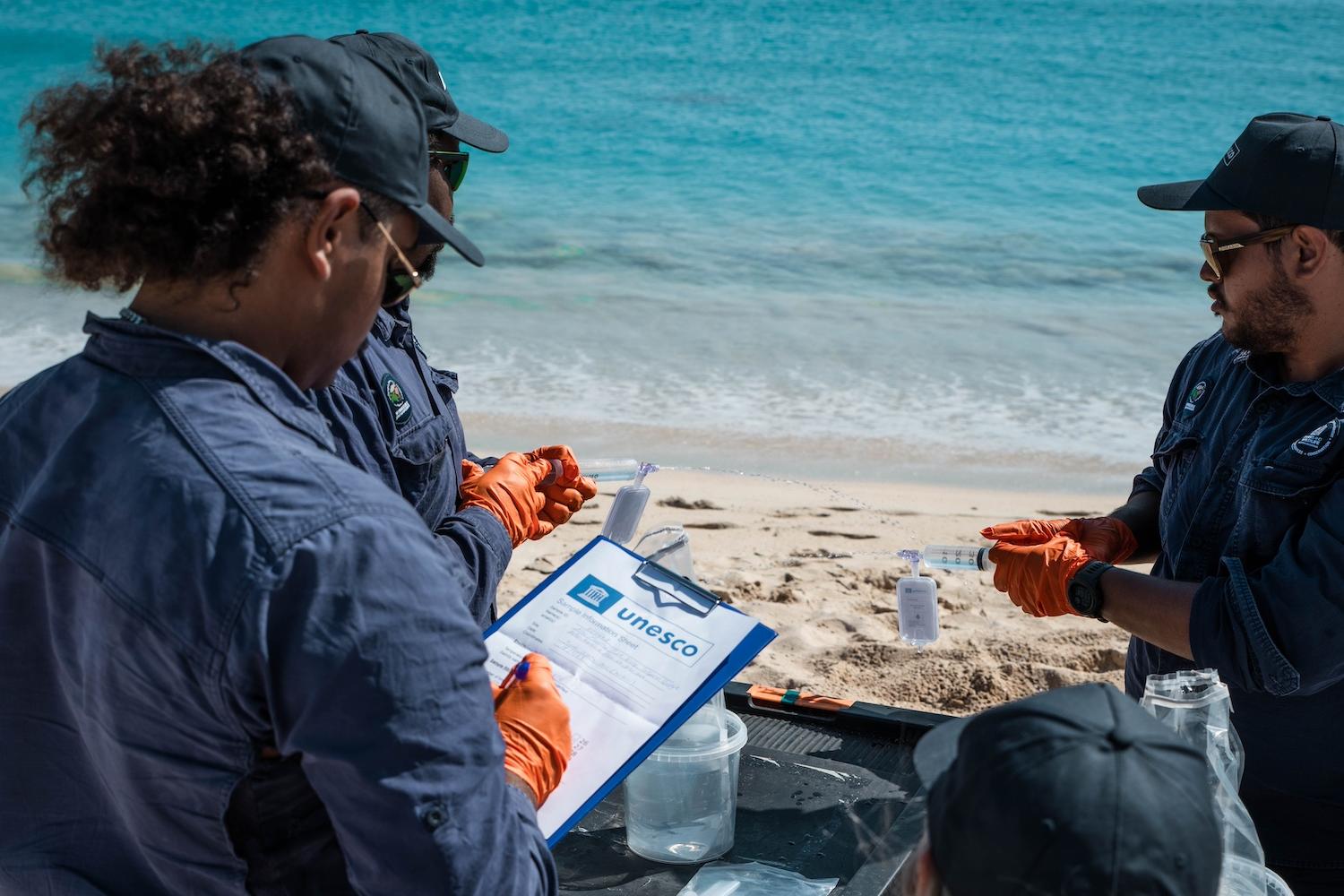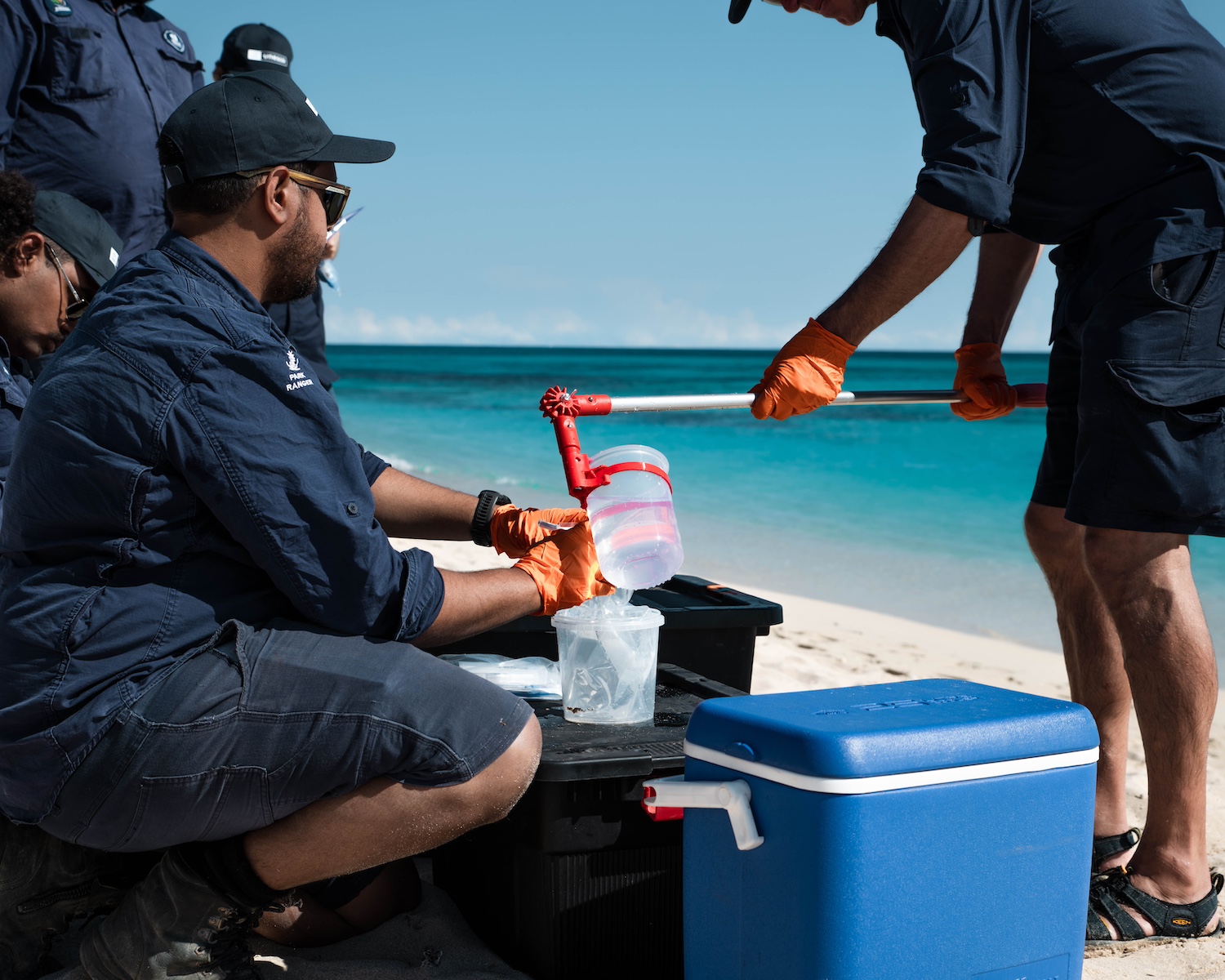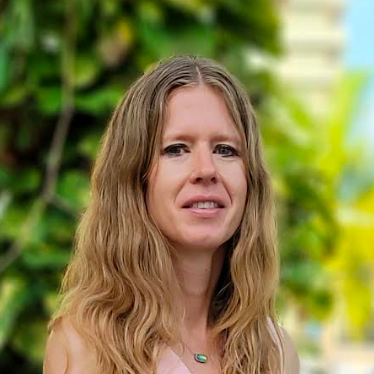
Scientists sample environmental DNA (eDNA) at a World Heritage marine site along Australia's Ningaloo Coast. (Image: Western Australia Department of Biodiversity, Conservation and Attractions)
Our power of degradation exceeds the depths of the ocean — literally. The oceans have over 1.3 billion cubic kilometers of water, but they’re still warming up. They’ve absorbed 90 percent of the heat from rising greenhouse gas emissions, triggering sea level rise, marine heat waves, coral bleaching and biodiversity loss.
Many marine species have already gotten the memo and shifted northwards or to deeper waters. But a warming climate isn’t the only menace to our seas, pollution, invasive species, coastal development and overfishing all pose risks. Consequently, almost 33 percent of reef-forming corals and sharks and more than a third of all marine mammals are listed as threatened with extinction, according to the Intergovernmental Science-Policy Platform on Biodiversity and Ecosystem Services.
Tracking marine life can help. To aid conservation efforts, the United Nations Educational, Scientific and Cultural Organization (UNESCO) sampled environmental DNA across 21 marine sites — using them as proxies for a global network.
Collected from the soil, water, or air, environmental DNA (eDNA) offers an easier and faster way to monitor biodiversity than traditional sight- or sound-based techniques. The organization hopes this technique can be applied across the 18,000 marine protected areas worldwide. Ultimately, the goal is to help protect the oceans — and their teeming life — during this period of rapid change.
The depths of DNA in the oceans
Starting in 2022, the eDNA expeditions collected 500 samples from UNESCO World Heritage marine sites scattered across the globe, which are protected for their unique biodiversity, ecosystems, geological processes or beauty.
Fish and other marine organisms shed genetic material into the water, including waste, mucus, or cells, which are picked up during sampling. For example, eDNA methods can detect approximately 100 marine species in a 1.5-liter water sample.
“We detected, in this pilot phase, nearly 4,500 species, which is quite amazing if you look at the actual cost of this technique and also the time that it takes to actually get to that kind of results,” Fanny Douvere, the head of UNESCO’s World Heritage Marine Program, said during a press conference hosted by the organization. “This amount of species is equivalent to about 10 to 20 percent of the local fauna that you're finding in these locations.”
The species were predominantly fish but also included sharks, rays, mammals and turtles. The project also detected 120 species listed as vulnerable, endangered or critically endangered.
At a global scale, UNESCO’s eDNA methodology reduces the time it would take for marine research and monitoring from years down to a few months, Douvere said. Its work would have cost millions of dollars if done with traditional surveys.
The samples were taken locally, often involving citizen scientists, but were shipped to and analyzed in Belgian laboratories. Once processed, the data was uploaded to an online dashboard and UNESCO’s open-access Ocean Biodiversity Information System.
All of this makes eDNA a rapidly scalable method that’s accessible to even the most resource-limited and the most remote locations, Douvere said.
“Environmental DNA, in and of itself, is a technique that has been around for a number of years,” Douvere said. “But what UNESCO did is to develop that into a more standardized approach that is affordable, and non-invasive as well.”
Despite the abundant benefits, eDNA sampling does have its limitations. For example, it doesn’t provide information on how abundant a species is, whether it is a resident or just passing through the site, or even if it’s dead or alive. These methods also rely on a reference library of species’ DNA for the target region.
“One of the critiques that we always hear is eDNA, it's fine, but the reference libraries are not complete,” Ward Appeltans, manager of UNESCO’s Ocean Biodiversity Information System, said during the press conference. “So you can't really use it.”
But at a sampling site on the Ningaloo Coast of Western Australia, the project successfully identified species for about half of the DNA sequences, he said. And these techniques will continue to improve as more reference libraries are developed. Plus, as a double check, the UNESCO project verified their species lists with existing databases, reports and publications.

Monitoring with a conservation mindset
Overall, UNESCO’s initiative is a step toward the Kunming-Montreal Global Biodiversity Framework’s goal to protect 30 percent of the world’s land, sea and inland waters by 2030. And the oceans need it.
“Today just over 8 percent of the ocean is protected, so there's over 20 percent that still is awaiting some form of protection by 2030,” Douvere said. “[eDNA] allows managers and scientists in all of these different places to get a fast grasp of what's actually happening locally and what management actions those local management teams can, and will, need to take to make sure that these areas are being protected. Because if we aren't protecting the right 30 percent because marine species have moved elsewhere, we're not going to get to the 30 percent by 2030. We're going to miss the boat.”
The project’s dashboard can help by predicting at-risk species for each site under different climate scenarios, Appeltans said. For example, in the Scandola Nature Reserve in Corsica, France, a three-degree increase in temperature would be too hot for more than 50 percent of the species.

Besides noting beneficial animals, eDNA sampling also finds something less desirable: invasive species.
“It's really important that you detect the invasive species as soon as possible before it spreads,” Appletans said. “It's like a wildfire — you want to stop the fire before it spreads. Invasive species are the same thing. If you don't react immediately and try to take away those invasive species, it's almost impossible to control.”
Another advantage of the project is the involvement of citizen scientists and students.
“It gave us the opportunity to reach out to a nearby high school, inviting 15-year-old students to join us to sample Florida Bay,” G. Melodie Naja, director of the South Florida Natural Resources Center, said during the press conference. The students were taught how to collect samples in a lab and then participated in collecting samples on the bay.
“That's when you see the importance of this all. You see how these young minds learned about this global effort. They connected the dots from the lab to the importance of marine biodiversity,” Naja said. “That's how this UNESCO effort helped us here in Everglades National Park by making this connection and fostering this next generation of conservationists.”

The future sea of life
The oceans are biodiversity hotspots, providing us with food, medicine, recreation and tourism opportunities. And they are a vital carbon sink, absorbing about 25 percent of the world’s carbon dioxide emissions. These ecosystems contribute over $3 trillion in goods and services every year, with two-thirds of that value relying on healthy environmental conditions.
World Heritage marine sites are just a slice of the blue sea, but they have over one-third of the world’s vulnerable and endangered species. Using this network as a stepping stone for global marine conservation is a massive goal, yet not unfathomable. All it takes is one sample at a time.

Ruscena Wiederholt is a science writer based in South Florida with a background in biology and ecology. She regularly writes pieces on climate change, sustainability and the environment. When not glued to her laptop, she likes traveling, dancing and doing anything outdoors.














